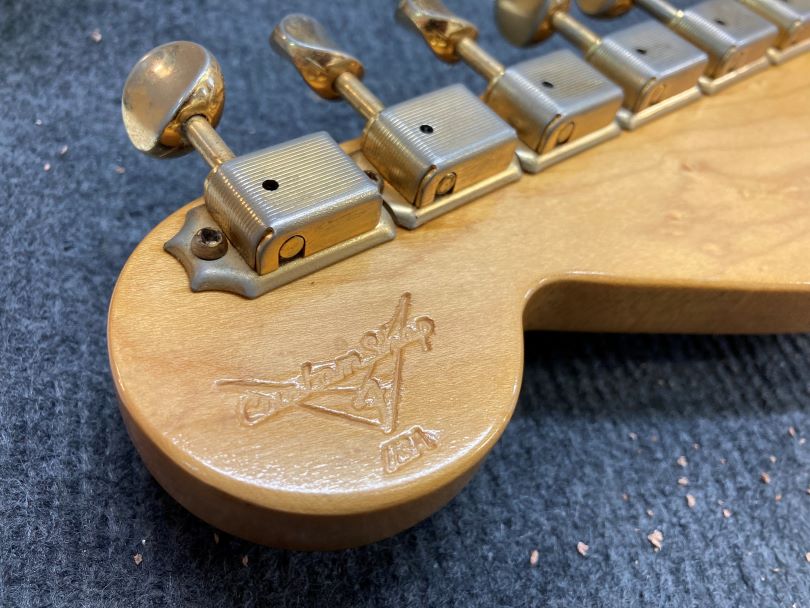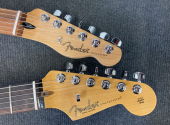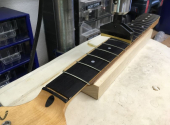Under the Hood #35: A Timeline History of Fender (Part 3)
In the next part of Fender's timeline history, we'll go through the important milestones of the 1980s. Many changes took place during these years – people at Fender were aware of the declining quality of the instruments they were making. Still, they were also full of new ideas, some of which were then implemented and became the pillars on which the Fender brand has been building till now. Examples include manufacturing in Japan, the creation of the Custom Shop and the buyout of Fender back from CBS.
1981: neck/body joint with four screws on all models
Since 1981, all instruments have had a four-bolt neck/body joint again. The construction of guitars has thus regained an essential, proven and quality element. Paradoxically, one of the first Squier models, launched two years later, had a neck/body joint with only three screws. However, the quality of this joint was closely watched, and it worked.
1981: the beginning of Dan Smith's era
After the arrival of Dan Smith, things started to move at Fender – the company's management became aware of the deteriorating quality of production. Smith and the people around him were therefore tasked with analysing the production processes and product quality and coming up with solutions. In short: they were supposed to reclaim Fender's reputation. After an initial analysis, it turned out that the entire production process needed to be completely overhauled, including proper employee training.
In a sense, manufacturing in Japan comes to the rescue.
1981/82: formation of Fender Japan
In 1981 and 1982, negotiations took place in Japan and production started there. After a rigmarole, it was finally successful and the official production of Japanese Fenders was established.
Japanese production has been known for many years not only for producing copies of American brands but also for its rising quality. This made everything easier – the manufacturing know-how had been ready, and by establishing Fender Japan, it was easily controlled.
When the first batch of Japanese-made guitars arrived at Fender, everyone was reportedly excited, even moved because the quality was beyond expectations. On the one hand, this was a pleasing finding, but on the other hand, it was a big warning signal that there was something wrong with American production (if the Japanese one was overtaking it).
At the time, the Fullerton factory was undergoing a revival process after Smith's arrival. As a result, many production processes were being abandoned, re-evaluated or completely redesigned, and employees needed to be trained to higher production standards. Production capacity and tool quality were therefore not satisfactory at the very beginning. And production in Japan gave Fender the time it needed for American production to rally. As a result, Fender continued to produce quality models during this transitional period, albeit in another country.
1981: end of production of the Bronco
In 1981, things started to get moving at Fender. One of the changes was discontinuing the Bronco, an offset guitar from the student model line. It differed from other models in that it only had a bridge pickup. Today this guitar is somewhat forgotten, which is a shame because, in hindsight, it is a successful model.
1982: production of Musicmaster discontinued
In 1982, production of the Musicmaster model ended. This guitar had been produced since 1956 and was the first student model. The Musicmaster I was produced with a 22.5 scale length; the later Musicmaster II was a 24 scale, therefore suitable for a broader range of players.
1982: Mustang production ends
In 1982, the Fender Mustang was discontinued. Thus the era of student models ended, only to be produced as reissue models in the following years.
1982: founding of Squier by Fender
In 1982, the first batch of export guitars with the Squier by Fender brand was released to the world. The first series was called JV.
1982: first reissue models
In 1982, the first reissue models came on the market: Stratocaster 57 and 62 (the numbers refer to the years they were produced). It was Dan Smith who worked on the design of these models. The intention was to make guitars based on popular models from the golden era. Models made before 1985, when the Fullerton factory closed, would later be called Fullerton reissues.
1983: Squier SQ
The first pieces of Squier Stratocaster "SQ" arrive in the US and Europe. Together with the JV series, these are high-quality guitars that have been sought after up to now.
1984/1985: a group of employees buys Fender from CBS
In 1984, negotiations began for a buyout of Fender from CBS, which had been preparing for the move for some time. This was an important milestone in the brand's history, as it marked Fender's break from its corporate management style. At the same time, at this point, the effort to get Fender back on top began. This brought with it many alterations but also many challenges and ideas, many of which were later implemented. The whole process of the company's buyout by the people around Dan Smith was completed in early 1985.
So the CBS era lasted about 20 years and left a very contradictory mark. There is a lot of debate on the subject, which is good. Undoubtedly, Fender became a truly global brand during this period, reaching many customers and growing into a significant company. So in a sense, everything moved forward in that period, especially regarding business.
On the other hand, the quality of the products suffered and gradually declined to the point that in the early 1980s, the company had to hire Yamaha experts to fix the quality problems. It all led to the paradoxical situation that Dan Smith and his colleagues had to buy several old Fender models from the golden era from a shop to examine them in the factory and start making quality pieces again – which they did.

1985: Fullerton ends, Corona starts
In 1985, after the Fender buyout from CBS, problems persisted with the Fullerton factory, which was not part of the buyout. Working there was no longer possible, so production was moved to the Corona factory. Another long and glorious era of one important place was over.
1985: Freddie Tavarez quits Fender
After many years, Freddie Tavarez leaves Fender. The man who was instrumental in the finishing touches and design of the Stratocaster.
1987: The Custom Shop is founded
In 1987, one of the new ideas was the Custom Shop concept. The main goal was to produce guitars of the same quality and using the same processes as in the golden era of Fender, i.e. the 1950s and the first half of the 1960s.
Initially, the intention was to try making customized guitars according to special, individual requirements. The trend in the specification of instruments would not be dictated by the manufacturer but by the customer. However, the first customers were professional musicians, so the bar was raised very high. Gradually, the Custom Shop became a large and serious business, which is still popular today thanks to its quality and variety.
The year 1987 was interesting for one more fundamental thing: the creation of a line of guitars called Fender American Standard. We'll talk more about these models and the further development of the modern era of Fender in the next part...
If you have found an error or typo in the article, please let us know by e-mail info@insounder.org.



